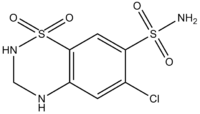Distal diuretics
From WikiLectures
Here we mainly include thiazide diuretics (thiazides), for which we distinguish:
- 'Renal effect: Thiazides inhibit NaCl reabsorption by distal tubule epithelial cells into blood. At the same time, they increase reabsorption in the distal tubule Ca 2+ ;
- extrarenal effect: vasodilation in the postcapillary bed reduces the return of blood to heart and subsequently cardiac output. Vascular resistance decreases after 2-3 weeks.
Shortcuts[edit | edit source]
The main representatives are:
- hydrochlorothiazide,
- chlorthalidone.
Other representatives include: chlorothiazide, trichloromethiazide, bendroflumethiazide, methipamide, indapamide.
Indication[edit | edit source]
- Arterial hypertension;
- heart failure;
- nephrolithiasis caused by idiopathic hypercalciuria;
- diabetes insipidus - they reduce the volume of urine in patients.
Contraindications[edit | edit source]
- decreased kidney function;
- pregnancy;
- bottom;
- hypercalcemia.
Side effects and toxicity[edit | edit source]
- Hypokalaemic metabolic alkalosis and hyperuricemia.
- Reduced glucose tolerance.
- May manifest hyperglycemia in diabetics and individuals with abnormal results Glucose Test. It is caused by a reduction in the release of insulin from pancreas.
- Thiazides lead to an approximately 5-15% increase in cholesterol and lipoproteins (LDL) in the blood. Due to long-term administration, these values may normalize.
- Dilution hyponatremia.
- This is a serious side effect. It is the result of increased ADH production due to hypovolemia, decreased dilution capacity Kidneys and thirst. It can be prevented by reducing the dose of the diuretic or reducing water intake.
Links[edit | edit source]
Related Articles[edit | edit source]
Source[edit | edit source]
- MARTÍNKOVÁ, Jiřina – MICHUDA, Stanislav. Selected chapters from clinical pharmacology for bachelor study : Cardiovascular system [online]. ©2000. [cit. 2010-07-02]. <https://www.lfhk.cuni.cz/farmakol/predn/bak/kapitoly/prednasky/kardio-bak.ppt/>.
- lectures by doc. Trejtnar, PharmDr. String


